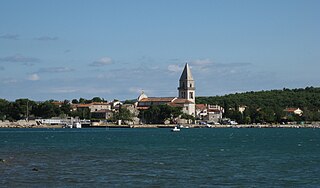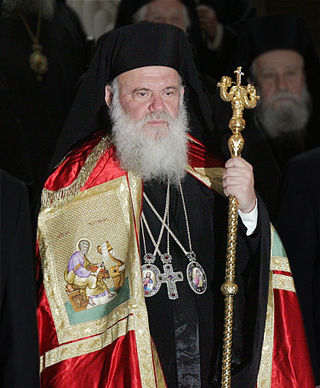Related Research Articles
In Christian denominations, an archbishop is a bishop of higher rank or office. In most cases, such as the Catholic Church, there are many archbishops who either have jurisdiction over an ecclesiastical province in addition to their own archdiocese, or are otherwise granted a titular archbishopric. In others, such as the Lutheran Church of Sweden, the title is only borne by the leader of the denomination.

The Duchy of Athens was one of the Crusader states set up in Greece after the conquest of the Byzantine Empire during the Fourth Crusade as part of the process known as Frankokratia, encompassing the regions of Attica and Boeotia, and surviving until its conquest by the Ottoman Empire in the 15th century.

The Duchy of the Archipelago, also known as Duchy of Naxos or Duchy of the Aegean, was a maritime state created by Venetian interests in the Cyclades archipelago in the Aegean Sea, in the aftermath of the Fourth Crusade, centered on the islands of Naxos and Paros. It included all the Cyclades. In 1537, it became a tributary of the Ottoman Empire, and was annexed by the Ottomans in 1579; however, Christian rule survived in islands such as Sifnos and Tinos.

William of Villehardouin was the fourth prince of Achaea in Frankish Greece, from 1246 to 1278. The younger son of Prince Geoffrey I, he held the Barony of Kalamata in fief during the reign of his elder brother Geoffrey II. William ruled Achaea as regent for his brother during Geoffrey's military campaigns against the Greeks of Nicaea, who were the principal enemies of his overlord, the Latin Emperor of Constantinople Baldwin II. William succeeded his childless brother in the summer of 1246. Conflicts between Nicaea and Epirus enabled him to complete the conquest of the Morea in about three years. He captured Monemvasia and built three new fortresses, forcing two previously autonomous tribes, the Tzakones and Melingoi, into submission. He participated in the unsuccessful Egyptian crusade of Louis IX of France, who rewarded him with the right to issue currency in the style of French royal coins.
Narona was an Ancient Greek trading post on the Illyrian coast and later Roman city and bishopric, located in the Neretva valley in present-day Croatia, which remains a Latin Catholic titular see.

Koroni or Corone is a town and a former municipality in Messenia, Peloponnese, Greece. Since the 2011 local government reform it is part of the municipality Pylos-Nestor, of which it is a municipal unit. Known as Corone by the Venetians and Ottomans, the town of Koroni sits on the southwest peninsula of the Peloponnese on the Gulf of Messinia in southern Greece, 56 km (35 mi) by road southwest of Kalamata. The town is nestled on a hill below a Venetian castle and reaches to the edge of the gulf. The town was the seat of the former municipality of Koróni, which has a land area of 105 km2 (41 sq mi) and a population of 4,366. The municipal unit consists of the communities Akritochori, Charakopio, Chrysokellaria, Falanthi, Kaplani, Kompoi, Koroni, Vasilitsi, Vounaria and Iamia. It also includes the uninhabited island of Venétiko.

The Duchy of Neopatras was a principality in southern Thessaly, established in 1319. Officially part of the Kingdom of Sicily, itself part of the Crown of Aragon, the duchy was governed in conjunction with the neighbouring Duchy of Athens, it enjoyed a large degree of self-government. From the mid-14th century, the duchies entered a period of decline: most of the Thessalian possessions were lost to the Serbian Empire, internal dissensions arose, along with the menace of Turkish piracy in the Aegean and the onset of Ottoman expansion in the Balkans. Enfeebled, the Catalan possessions were taken over by the Florentine adventurer Nerio I Acciaioli in 1385–1390. The title of Duke of Neopatras was held by the heir of the King of Sicily.

Osor is a village and a small port on the Croatian island of Cres, in Primorje-Gorski Kotar. Administratively, it is part of the town of Mali Lošinj. As of 2021, it had a population 26.

The Frankokratia, also known as Latinokratia and, for the Venetian domains, Venetokratia or Enetokratia, was the period in Greek history after the Fourth Crusade (1204), when a number of primarily French and Italian states were established by the Partitio terrarum imperii Romaniae on the territory of the dissolved Byzantine Empire.

The Archdiocese of Athens is a Latin Church ecclesiastical territory or archdiocese of the Catholic Church in Greece. Its cathedra is found within the neoclassic Cathedral Basilica of St. Dionysius the Areopagite, in the episcopal see of Athens.

The Lordship of Salona, after 1318 the County of Salona, was a Crusader state established after the Fourth Crusade (1204) in Central Greece, around the town of Salona.
The Metropolis of Corinth, Sicyon, Zemenon, Tarsos and Polyphengos is a metropolitan see of the Church of Greece in Corinthia, Greece. Since the Middle Ages it has also existed as a Roman Catholic titular see. The current metropolitan is Dionysios Mantalos.
The Latin Archbishopric of Corinth is a titular see of the Roman Catholic Church. It dates to 1210, when a Catholic archbishop was installed on the Orthodox Metropolis of Corinth, in Southern Greece, in the aftermath of the Fourth Crusade. Since the Byzantine reconquest in the early 15th century, and except for a brief period of Venetian rule in 1688–1715, it has been awarded as a titular see. It has been vacant since 2005.

The Archbishopric of Athens is a Greek Orthodox archiepiscopal see based in the city of Athens, Greece. It is the senior see of Greece, and the seat of the autocephalous Church of Greece. Its incumbent is Ieronymos II of Athens. As the head of the Church of Greece, the holder is styled Archbishop of Athens and All Greece.
Paul was a Roman Catholic bishop from southern Italy who held various episcopal sees in the Latin East, before becoming titular Latin Patriarch of Constantinople. He was engaged in several negotiations for a possible Union of the Churches with the Byzantine Empire.
Dorotheus I was the Greek Orthodox metropolitan bishop of Athens from c. 1388 to 1392, and the first to reside in the city since 1205.
The Latin Archbishopric of Thebes is the see of Thebes in the period in which its incumbents belonged to the Latin or Western Church. This period began in 1204 with the installation in the see of a Catholic archbishop following the Fourth Crusade, while the Orthodox metropolitan bishop fled the city.
James Fadrique was a Catalan nobleman who became Count of Salona, as well as Lord of various other towns in Central Greece from ca. 1355 until his death in 1366.
The Second Parliament of Ravennika was convened in May 1210 by Latin Emperor Henry of Flanders in the town of Ravennika in Central Greece in order to resolve the differences between the princes of Frankish Greece and the Roman Catholic clergy of their domains.
The Metropolis of Kitros, Katerini, and Platamon is an Eastern Orthodox metropolis of the Church of Constantinople, but is de facto is administered for practical reasons as part of the Church of Greece.
References
- ↑ Setton 1976, p. 409.
- ↑ Setton 1976, pp. 409–410 (note 28).
- ↑ Setton 1976, pp. 188 (note 117), 455.
- ↑ Setton 1976, p. 466.
- ↑ "Salona (Titular See): Past and Present Ordinaries". Catholic-Hierarchy.org . Retrieved 27 October 2016.




